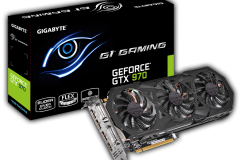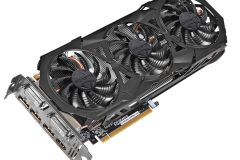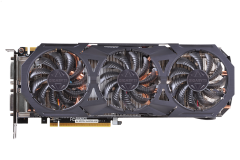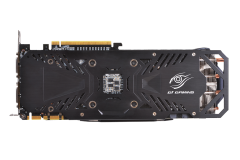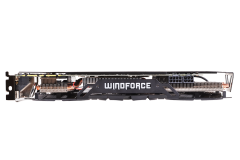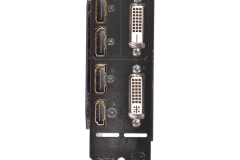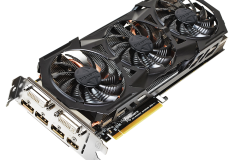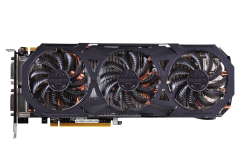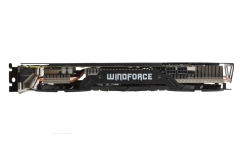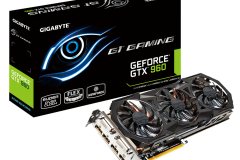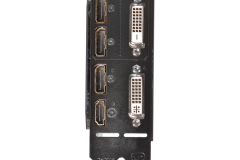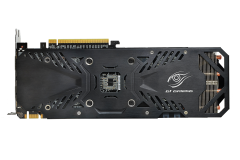On the face of it, these two WINFORCE 3X cooled cards look very similar but when you sit them next to each other, there is a subtle difference in the lighting on the top and the length of the PCB sandwiched in the middle of the card, but that’s about it. The GTX 960 has 2 extra lights on the top to indicate when the fan is stopped and a slightly shorter PCB. The manufacturer specifications didn’t match our review samples in terms of physical size so we provided our updates below. Both cards have both an 8-pin and a 6-pin power connector.The GTX 960 is also 16g heavier – probably due to the 21 thicker/taller fins on the heat sink at the end of the card, made possible by the shorter PCB.
The connectivity is made up of 1x Dual Link DVI-I, 1x Dual Link DVI-D, 1x HDMI and 3x Display Port. By adding the extra DVI port on the rear I/O plate, both cards will not exhaust warm air outside the case, making active case airflow more important. This shouldn’t be a problem for most builds as modern cases typically have good airflow, and cable tidy/anchor points. It is worth noting that the extra connectivity comes with a slight trade-off so keep it neat inside your case, even if you don’t have a window.
The GTX 970 G1 Gaming 4GD promo shots can be seen below
Now, here are the GTX 960 G1 Gaming 2GD promo shots
The specifications of both Gigabyte Gaming GTX 960 & 970 cards are listed below.
|
Gigabyte |
Gigabyte |
|
|
Graphics Engine |
NVIDIA GeForce GTX 960 |
NVIDIA GeForce GTX 970 |
|
Interface |
PCI Express x16 3.0 |
PCI Express x16 3.0 |
|
Memory Type |
GDDR5 |
GDDR5 |
|
Memory Size(MB) |
2048 |
4096 |
|
Memory Interface |
128 bits |
256 bits |
|
Core Clock Speed(MHz) |
OC Mode GPU Boost Clock : 1329 MHz GPU Base Clock : 1266 MHz Gaming Mode GPU Boost Clock : 1304 MHz GPU Base Clock : 1241 MHz |
OC Mode Gaming Mode |
|
Memory Clock Speed(MHz) |
7010 |
7010 |
|
DVI Output |
1 (Dual-link DVI-I)
1 (Dual-link DVI-D) |
1 (Dual-link DVI-I)
1 (Dual-link DVI-D) |
|
HDMI-Output |
1 |
1 |
|
DisplayPort |
3 |
3 |
|
Maximum Displays |
4 |
4 |
|
HDCP Support |
Y |
Y |
|
DirectX Version Support |
12 |
12 |
|
OpenGL Version Support |
4.4 |
4.4 |
|
SLI Support |
Y, 2-Way |
Y, 3-Way |
|
Card Dimension(mm) |
295 x 114 x 43mm (listed) 295 x 129 x 43mm (as measured) |
312 x 129 x 43mm (listed) 295 x 129 x 43mm (as measured) |
|
Weight |
816g (as weighed) | 800g (as weighed) |
|
Power Consumption (W) |
120W (Est.) |
145W (Est.) |
| Power Connectors | 6-Pin x1, 8-Pin x1 | 6-Pin x1, 8-Pin x1 |
| Accessories | 1×8-pin MOLEX power cable 1×6-pin MOLEX power cable |
1×8-pin MOLEX power cable 1×6-pin MOLEX power cable |
GTX 900 series standard technology
Voxel Global Illumination (VXGI)
Maxwell GPUs are the first with the ability to dynamically render indirect list using VXGI technology. Light interacts more realistically in the game environment for a more life-like experience
MFAA – Multi Framed Sampling Aliasing
Next generation Anti-Aliasing to lessen the trade-off between high settings and lower frame rates. NVIDIA states that MFAA is effectively the same graphical result as 2x MSAA but with the performance of having no MSAA active. There is a video explaining it below
{youtube}Nef6yWYu0-I{/youtube}
DSR – Dynamic Super Resolution Technology
NVIDIA describe this as “The GeForce GTX 980 and 970 deliver the graphics horsepower to render images at 4K resolution. They use DSR technology—which uses an advanced filter to scale down the image—to provide gamers with a 4K experience on a 1080p monitor. Each game is automatically optimised using GeForce Experience™, ithout compromising performance.” see the video below for an example
{youtube}rSUSYaa6C9s{/youtube}
4K
The GTX 970/980 GPUs have been designed with 4K gaming in mind and have other features like G-SYNC and 4K Capture through ShadowPlay to improve the 4K gaming experience.
G-SYNC
NVIDIA have removed input lag that we see with VSYNC and reversed the traditional way of smoothing out gameplay where graphics cards would try to synchronise their output with the refresh rate of the screen. G-SYNC uses monitors that have the NVIDA technology included at a hardware level to adjust the monitor refresh rate to match the output of the graphics card. This is designed to provide a smoother visual experience leaving stuttering screen tearing in the past. The number of G-SYNC monitors on the market is growing and with more options on the market, the price should become more affordable as time and competing technologies further develop.
Familiar Friends from previous generations
GPU BOOST 2 will boost performance to remain under a thermal target. This means that the performance when the card is maxed out may be more than the boost clock if the card is cool enough.
Adaptive V-Sync. This has been around for a little while with NVIDIA cards but it works to reduce/eliminate tearing by turning V-Sync off when the frame rate drops below the refresh rate of the monitor.

